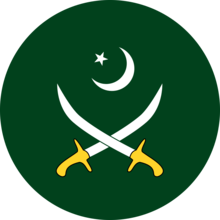National Guard of Pakistan
The National Guard of Pakistan is a paramilitary force and one of four reserve components of the Pakistan Army, designed to act as a "second line of defence",[3]:84 together with the Pakistan Army Reserve, the Frontier Corps and the Pakistan Rangers.[2]
| Pakistan National Guard | |
|---|---|
| قومى محافظ | |
 | |
| Founded | 3 January 1948[1] |
| Country | |
| Allegiance | Government of Pakistan (The National Guards Act, 1973) Provincial governments in Pakistan |
| Branch | |
| Type | Reserve component |
| Role | Border control, law enforcement, first responders |
| Size | ~185,000[2]:notes/contents |
| Garrison/HQ | Army GHQ, Rawalpindi |
| Colours | Green and White |
| Anniversaries | Defence Day: September 6 |
| Engagements | Indo-Pakistani wars and conflicts
Global War on Terror Siege of Lal Masjid War in North-West Pakistan Balochistan conflict |
| Website | www |
| Commanders | |
| Chief of Army Staff | General Qamar Javed Bajwa, |
| Director-General, National Guards | Maj-Gen. Faheem-ul-Aziz |
| Notable commanders | Brig. Shahid Hamid Maj-Gen. Akbar Khan |
History
The National Guard was established on 1 January 1948 as a reserve component of the Pakistan Army, first advertised as the volunteer corps later expanded as a Women's Guard.[4][3]:84–85 Prime Minister Liaquat Ali Khan appointed Brigadier Syed Shahid Hamid as its first chief, and later delegated the command to Major-General Akbar Khan.[1]:268
Organization
The command and control of the National Guard is under the Chief of Army Staff who serves as the Principal Officer Commanding from Army GHQ in Rawalpindi.[3]:notes
The National Guard is composed of 79 battalions, including six artillery and five training battalions. It is (and was) composed of the following combat organizations:
- Mujahid Force of 60,000, organized in infantry battalions, Some units were deployed in Azad Kashmir and a few units were serving in the cantonments. Recently, some Mujahid Regiment units were transformed into fully activated SAM battalions.[2]
- Janbaz Force of 100,000, operates under the control of the provincial governments,[2] and its members tend to serve close to their home districts.[2]
- National Cadet Corps (dissolved)[2][4]
- Women's Guard (dissolved)[2][4]
The two current components, the Mujahid Force and the Janbaz Force, are recruited, trained and serve locally, and are mainly charged with air defence and dealing with national calamities.[2]:notes/contents
One of the latter two programs, the National Cadet Corps, was similar to the United States ROTC. The National Cadet Corps was disbanded in 2006.[5]
The second was the Women's Guard which included individuals trained in nursing, welfare, and clerical work. There were also some women in the Janbaz Force, and a very small number of women were recruited into regular service to perform medical and educational work.
See also
- Paramilitary forces of Pakistan
- Pakistan Rangers
- Frontier Corps
- Frontier Constabulary
- Airport Security Force (Pakistan)
- Pakistan Coast Guard
References
- Hamid, S. Shahid (1993). Early Years of Pakistan: Including the Period from August, 1947 to 1959 (snippet view). Ferozsons. p. 305. ISBN 9789690100627. Retrieved 25 October 2018.
- Katoch, Lt Col H. (2013). "§(Pakistan)". Territorial Army: Future Challenges (google books). Vij Books India Pvt Ltd. ISBN 9789382573760. Retrieved 25 October 2018.
- Cheema, Pervaiz I.; Riemer, Manuel (1990). "Early Developments". Pakistan's Defence Policy 1947-58 (Google Books). Springer. p. 240. ISBN 9781349209422. Retrieved 25 October 2018.
- "Journey from Scratch to Nuclear Power". www.pakistanarmy.gov.pk. ISPR (Army). Retrieved 25 October 2018.
- United Nations High Commissioner for Refugees. "Pakistan: The paramilitary group Mujahid Force Regiment, especially its relationship with Inter-Services Intelligence (ISI) and whether it can compel a member to serve in ISI".